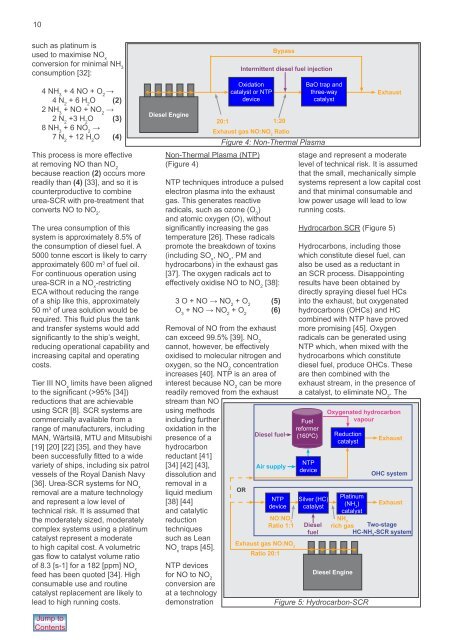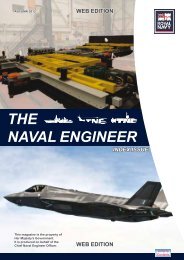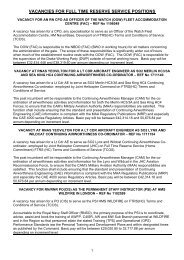THE NAVAL ENGINEER
THE NAVAL ENGINEER
THE NAVAL ENGINEER
You also want an ePaper? Increase the reach of your titles
YUMPU automatically turns print PDFs into web optimized ePapers that Google loves.
10<br />
such as platinum is<br />
used to maximise NO x<br />
conversion for minimal NH 3<br />
consumption [32]:<br />
4 NH 3<br />
+ 4 NO + O 2<br />
→<br />
4 N 2<br />
+ 6 H 2<br />
O (2)<br />
2 NH 3<br />
+ NO + NO 2<br />
→<br />
2 N 2<br />
+3 H 2<br />
O (3)<br />
8 NH 3<br />
+ 6 NO 2<br />
→<br />
7 N 2<br />
+ 12 H 2<br />
O (4)<br />
This process is more effective<br />
at removing NO than NO 2<br />
because reaction (2) occurs more<br />
readily than (4) [33], and so it is<br />
counterproductive to combine<br />
urea-SCR with pre-treatment that<br />
converts NO to NO 2<br />
.<br />
The urea consumption of this<br />
system is approximately 8.5% of<br />
the consumption of diesel fuel. A<br />
5000 tonne escort is likely to carry<br />
approximately 600 m 3 of fuel oil.<br />
For continuous operation using<br />
urea-SCR in a NO x<br />
-restricting<br />
ECA without reducing the range<br />
of a ship like this, approximately<br />
50 m 3 of urea solution would be<br />
required. This fluid plus the tank<br />
and transfer systems would add<br />
significantly to the ship’s weight,<br />
reducing operational capability and<br />
increasing capital and operating<br />
costs.<br />
Tier III NO x<br />
limits have been aligned<br />
to the significant (>95% [34])<br />
reductions that are achievable<br />
using SCR [8]. SCR systems are<br />
commercially available from a<br />
range of manufacturers, including<br />
MAN, Wärtsilä, MTU and Mitsubishi<br />
[19] [20] [22] [35], and they have<br />
been successfully fitted to a wide<br />
variety of ships, including six patrol<br />
vessels of the Royal Danish Navy<br />
[36]. Urea-SCR systems for NO x<br />
removal are a mature technology<br />
and represent a low level of<br />
technical risk. It is assumed that<br />
the moderately sized, moderately<br />
complex systems using a platinum<br />
catalyst represent a moderate<br />
to high capital cost. A volumetric<br />
gas flow to catalyst volume ratio<br />
of 8.3 [s-1] for a 182 [ppm] NO x<br />
feed has been quoted [34]. High<br />
consumable use and routine<br />
catalyst replacement are likely to<br />
lead to high running costs.<br />
Jump to<br />
Contents<br />
Diesel Engine<br />
Oxidation<br />
catalyst or NTP<br />
device<br />
Bypass<br />
Intermittent diesel fuel injection<br />
20:1 1:20<br />
Exhaust gas NO:NO 2<br />
Ratio<br />
Non-Thermal Plasma (NTP)<br />
(Figure 4)<br />
BaO trap and<br />
three-way<br />
catalyst<br />
Figure 4: Non-Thermal Plasma<br />
NTP techniques introduce a pulsed<br />
electron plasma into the exhaust<br />
gas. This generates reactive<br />
radicals, such as ozone (O 3<br />
)<br />
and atomic oxygen (O), without<br />
significantly increasing the gas<br />
temperature [26]. These radicals<br />
promote the breakdown of toxins<br />
(including SO x<br />
, NO x<br />
, PM and<br />
hydrocarbons) in the exhaust gas<br />
[37]. The oxygen radicals act to<br />
effectively oxidise NO to NO 2<br />
[38]:<br />
3 O + NO → NO 2<br />
+ O 2<br />
(5)<br />
O 3<br />
+ NO → NO 2<br />
+ O 2<br />
(6)<br />
Removal of NO from the exhaust<br />
can exceed 99.5% [39]. NO 2<br />
cannot, however, be effectively<br />
oxidised to molecular nitrogen and<br />
oxygen, so the NO 2<br />
concentration<br />
increases [40]. NTP is an area of<br />
interest because NO 2<br />
can be more<br />
readily removed from the exhaust<br />
stream than NO<br />
using methods<br />
including further<br />
oxidation in the<br />
presence of a<br />
hydrocarbon<br />
reductant [41]<br />
[34] [42] [43],<br />
dissolution and<br />
removal in a<br />
liquid medium<br />
[38] [44]<br />
and catalytic<br />
reduction<br />
techniques<br />
such as Lean<br />
NO x<br />
traps [45].<br />
NTP devices<br />
for NO to NO 2<br />
conversion are<br />
at a technology<br />
demonstration<br />
OR<br />
Diesel fuel<br />
Air supply<br />
NTP<br />
device<br />
NO:NO 2<br />
Ratio 1:1<br />
Exhaust gas NO:NO 2<br />
Ratio 20:1<br />
Fuel<br />
reformer<br />
(160ºC)<br />
NTP<br />
device<br />
Silver (HC)<br />
catalyst<br />
Diesel<br />
fuel<br />
Diesel Engine<br />
Figure 5: Hydrocarbon-SCR<br />
Exhaust<br />
stage and represent a moderate<br />
level of technical risk. It is assumed<br />
that the small, mechanically simple<br />
systems represent a low capital cost<br />
and that minimal consumable and<br />
low power usage will lead to low<br />
running costs.<br />
Hydrocarbon SCR (Figure 5)<br />
Hydrocarbons, including those<br />
which constitute diesel fuel, can<br />
also be used as a reductant in<br />
an SCR process. Disappointing<br />
results have been obtained by<br />
directly spraying diesel fuel HCs<br />
into the exhaust, but oxygenated<br />
hydrocarbons (OHCs) and HC<br />
combined with NTP have proved<br />
more promising [45]. Oxygen<br />
radicals can be generated using<br />
NTP which, when mixed with the<br />
hydrocarbons which constitute<br />
diesel fuel, produce OHCs. These<br />
are then combined with the<br />
exhaust stream, in the presence of<br />
a catalyst, to eliminate NO 2<br />
. The<br />
Oxygenated hydrocarbon<br />
vapour<br />
Reduction<br />
catalyst<br />
Exhaust<br />
OHC system<br />
Platinum<br />
(NH Exhaust<br />
3<br />
)<br />
catalyst<br />
NH 3<br />
rich gas Two-stage<br />
HC‐NH 3<br />
‐SCR system

















